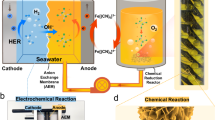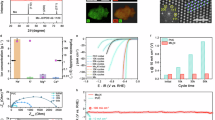Abstract
The change in the polarization potentials of anode and cathode due to pH change on electrode surfaces during galvanostatic polarization was examined in 0.5 M NaCl solutions of different pH. On the basis of these results, feeding of the anolyte after oxygen evolution to the cathode compartment for hydrogen production was examined for energy-saving seawater electrolysis. This was assumed to prevent the occurrence of a large pH difference on cathode and anode in electrolysis of neutral solution if sufficient H+ is permeated through the membrane. The cell performance was examined using Nafion 115 or Selemion HSF membranes for separation of anode and cathode compartments. The permeation fraction of H+ with Nafion 115 was 45–65% in 0.5 M NaCl and was about 90% in 0.25 M Na2SO4. These values were smaller than 97% necessary for prevention of the occurrence of pH difference on cathode and anode. The permeation fraction of H+ with Selemion HSF became more than 97% during electrolysis of 0.025 M Na2SO4, and the cell voltage was kept at low values. These results indicate the effectiveness of our seawater feeding system if the 97% H+ permeation fraction through the membrane is attained.










Similar content being viewed by others
References
Hashimoto K (1994) Mater Sci Eng A179/A180:27
Hashimoto K, Yamasaki M, Fujimura K, Matsui T, Izumiya K, Komori M, El-Moneim AA, Akiyama E, Habazaki H, Kumagai N, Kawashima A, Asami K (1999) Mater Sci Eng A267:200
Hashimoto K, Yamasaki M, Meguro S, Sasaki S, Katagiri H, Izumiya K, Kumagai N, Habazaki H, Akiyama E, Asami K (2002) Corros Sci 44:371
Hashimoto K (2006) Corrosion and electrochemistry of advanced materials. In: Hashimoto K, Fujimoto S, Akiyama E, Habazaki H, Macdougall B (eds) Electrochemical society transactions, Volume 1, Issue 4. The Electrochemical Society, Pennington, NJ, pp 533–544
Izumiya K, Akiyama E, Habazaki H, Kumagai N, Kawashima A, Asami K, Hashimoto K (1997) J Appl Electrochem 27:1362
Izumiya K, Akiyama E, Habazaki H, Kumagai N, Kawashima A, Asami K, Hashimoto K (1997) Mater Trans JIM 38:899
Izumiya K, Fujimura K, Akiyama E, Habazaki H, Kawashima A, Hashimoto K (1998) Proc. on EUROMAT’98, Conf. on Materials in Oceanic Environment, The Federation of European Materials Sciences p 37
Fujimura K, Izumiya K, Kawashima A, Habazaki H, Hashimoto K (1999) J Appl Electrochem 29:765
Fujimura K, Matsui T, Habazaki H, Kawashima A, Kumagai N, Hashimoto K (2000) Elecrtrochim Acta 45:2297
Habazaki H, Matsui T, Kawashima A, Asami K, Kumagai N, Hashimoto K (2001) Scripta Mater 44:1659
Abdel Ghany AN, Kumagai N, Meguro S, Asami K, Hashimoto K (2002) Electrochimica Acta 48:21
El-Moneim AA, Kumagai N, Asami K, Hashimoto K (2005) Mat Trans 46:309
Kato Z, Kumagai N, Asami K, Hashimoto K (2006) Corrosion and electrochemistry of advanced materials. In: Hashimoto K, Fujimoto S, Akiyama E, Habazaki H, Macdougall B (eds) Electrochemical society transactions, Volume 1, Issue 4. The Electrochemical Society, Pennington, NJ, pp 499–507
Author information
Authors and Affiliations
Corresponding author
Additional information
Contribution to the Fall Meeting of the European Materials Research Society, Symposium D: 9th International Symposium on Electrochemical/Chemical Reactivity of Metastable, Warsaw, 17th-21st September, 2007.
Rights and permissions
About this article
Cite this article
Kato, Z., Izumiya, K., Kumagai, N. et al. Energy-saving seawater electrolysis for hydrogen production. J Solid State Electrochem 13, 219–224 (2009). https://doi.org/10.1007/s10008-008-0548-9
Received:
Revised:
Accepted:
Published:
Issue Date:
DOI: https://doi.org/10.1007/s10008-008-0548-9




